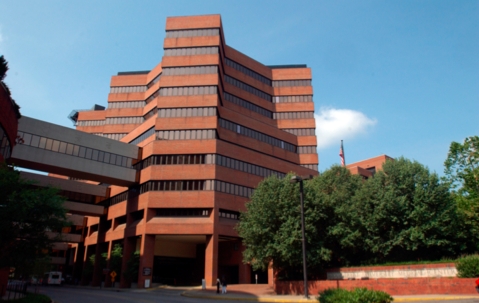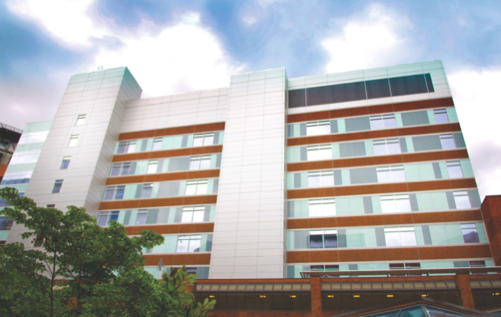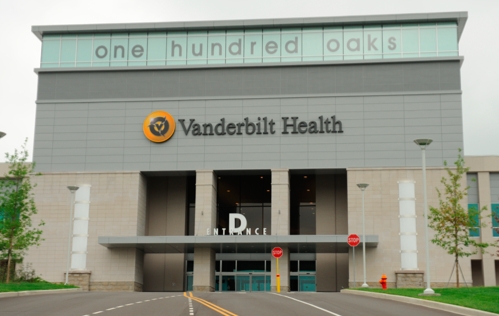Chronology of Major Buildings at VUMC
1925—Vanderbilt University Medical Center moved to 21st Avenue South and Garland. The building is a four-story structure with two east-west corridors, S and T (which stood for service and teaching), and intersecting north-south hallways A, B and C.
1925—Mary Ragland Godchaux Hall opened, housing the School of Nursing (at the time not a part of the Medical Center). The building was originally known as Mary Kirkland Hall, and had not only classrooms and offices, but also housing for more than 100 nurses.
1938—The first major expansion of the Medical Center saw the construction of the D corridor to allow more space for patient rooms, Pediatrics and Ob/Gyn.
1954—The S.R. Light Laboratory for Surgical Research was added to the hospital.

1955—The Medical Arts Building opened.
1961—A.B. Learned Laboratory was opened, vastly increasing the research space available to faculty and closing off the once open courtyard.
1962—The Round Wing (its original name, which didn’t stick, was the West Wing) opened.
1964—The A corridor was extended to provide space for, among other things, the Medical Center Library.

1967—The Zerfoss Student Health Building was added to the rear of the Medical Center.
1967—Medical Center South opened. It was later razed to make way for the expanded East Garage.
1972—The Joe and Howard Werthan Building, which replaced the original façade of the 1925 building facing 21st Avenue South, was completed.
1978—Light Hall and adjacent Langford Auditorium were completed.
1980—The new Vanderbilt University Hospital was opened. The old building was rechristened Medical Center North.

1985—The Psychiatric Hospital at Vanderbilt opened. It was originally known as the Vanderbilt Child and Adolescent Psychiatric Hospital, but was later converted to serve both adults and adolescents. It is now known as the Vanderbilt Psychiatric Hospital.
1988—The Vanderbilt Clinic opened, moving almost all outpatient services out of Medical Center North.
1989—The Kim Dayani Human Performance Center opened.
1989—The Ann and Roscoe R. Robinson Building opened. Its original name was the Medical Research Building.
1992—Medical Center East, primarily an outpatient services building, was opened.
1993—The Stallworth Rehabilitation Hospital opened.
1994—The Eskind Biomedical Library was dedicated.

1995—The Frances Williams Preston Building opened.Its original name was Medical Research Building II.
1996—VUMC’s first Williamson County clinic opened. As of 2012, the Medical Center has 16 locations and about 450 employees based in Williamson County.
1997—The Vanderbilt Page-Campbell Heart Institute opened.
1998—The School of Nursing’s Patricia Champion Frist Hall opened.
2001—The first major addition to Medical Center North since 1972, the mouse vivarium atop the Werthan Building, was completed.
2002—Medical Research Building III, an addition onto the Learned Lab section of Medical Center North, was completed.
2003—The Monroe Carell Jr. Children’s Hospital at Vanderbilt was completed.

2004—The first phase of the Doctors’ Office Tower, adjacent to the Monroe Carell Jr. Children’s Hospital at Vanderbilt, opened. Subsequent floors opened in 2005, 2009 and 2012.
2004—The Medical Center East South Tower, including the Bill Wilkerson Center, was completed.
2006—The Institute of Imaging Science was added to the southwest corner of Medical Center North.
2008—Medical Research Building IV was completed and the Langford Auditorium, renovated.
2008—The first VUMC clinic, Pediatric Rehabilitation, moved to One Hundred Oaks.

2009—The Critical Care Tower, the first significant addition to Vanderbilt University Hospital since it opened in 1980, opened.
2009—VUMC opened a second campus at One Hundred Oaks, with 440,000 feet of renovated space.


Leave a Response